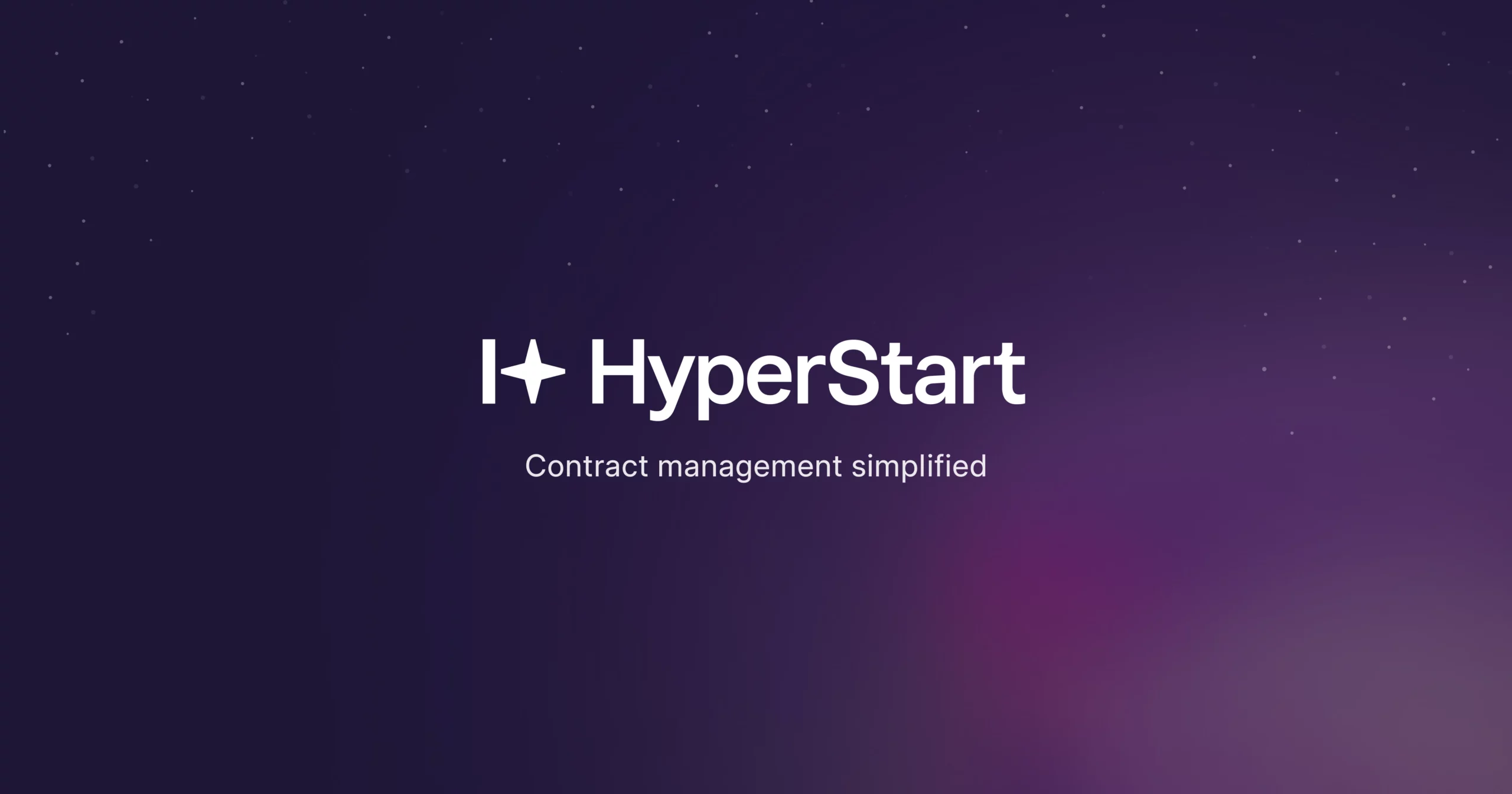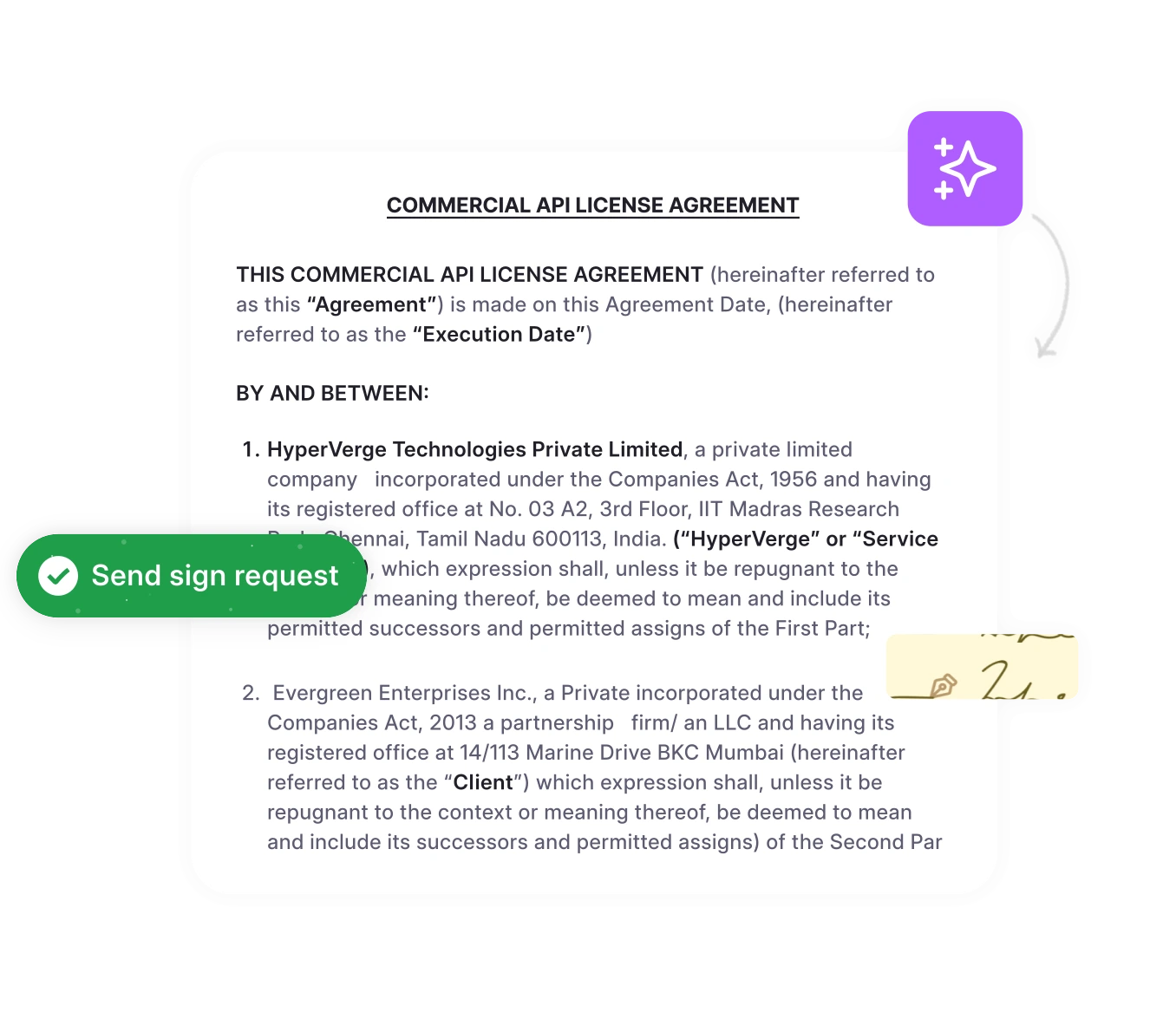Your General Counsel just asked about the status of 47 contracts expiring this quarter, and you’re scrambling through email threads, shared drives, and filing cabinets to track each contract renewal timeline.
Without a standardized contract renewal template, legal resources are wasted at every stage of the lifecycle. This common scenario costs organizations weeks in missed renewal opportunities.
The solution isn’t just better calendar reminders—it’s adopting comprehensive contract renewal templates that eliminate mundane drafting.
What is a contract renewal template?
A contract renewal template is a standardized document designed to streamline the process of extending or renewing existing contracts. It includes pre-approved language, key contract clauses, and essential terms that apply specifically to contract renewals, ensuring consistency and compliance across all agreements.
Using a contract renewal template helps legal and procurement teams save time and reduce errors. It provides a clear, ready-to-use framework that simplifies the administrative workload and accelerates the approval process. They also help minimize risks such as missed deadlines or unfavorable renewal terms, supporting smoother and more efficient contract management.
Without standardized templates or automated tracking, organizations face inconsistent language and missed deadlines. Let’s explore the common challenges that arise when renewal tracking lacks automation.
What are the challenges to contract renewal without a template?
Manual contract renewal tracking often creates operational inefficiencies that many legal teams have to deal with on a regular basis. However, this reality can lead to costly delays, missed deadlines, and unnecessary risks.
Pre-execution challenges
1. Direct productivity losses
Legal professionals spend considerable time per renewal recreating frameworks that should be standardized. For organizations processing multiple renewals quarterly, this represents expensive legal talent focused on administrative work instead of strategic legal analysis. When senior-level legal professionals are recreating basic renewal frameworks, organizations are paying premium rates for administrative tasks rather than strategic legal expertise. Strategic templates are essential for legal operations efficiency.
Calculate your exact renewal productivity costs: if your legal team processes 50+ renewals quarterly at $400/hour counsel rates, that’s $160,000+ in annual administrative waste. See your savings potential with HyperStart’s ROI calculator.
3. Inconsistent stakeholder coordination
Without standardized templates, different team members follow different processes for stakeholder engagement. This leads to delayed approvals, missed input from critical decision-makers, and renewals that don’t align with current business needs or budget cycles.
3. Inconsistent renewal terms and language across the organization
Without standardized templates, similar contracts end up with different terms, pricing structures, and compliance requirements. This creates complexity for legal teams managing multiple vendor relationships and makes it difficult to optimize contract portfolios strategically.
Post-execution challenges
1. Ongoing legal team burnout and dissatisfaction
Perhaps most critically, renewal chaos contributes to legal team burnout. Legal professionals didn’t attend law school to become document administrators, yet without proper renewal templates, sales teams need legal to review contracts every time a renewal or renegotiation is required. The brightest legal minds spend their time on repetitive renewal administration instead of strategic legal work that drives business value.
2.2. Revenue impact from missed renewals
Organizations face significant financial losses from missed renewal opportunities when manual tracking systems fail. Advanced contract tracking software eliminates these costly oversights. These aren’t just administrative oversights—they’re strategic business losses that directly impact growth and profitability. Even a single missed renewal of a major vendor agreement can result in unfavorable automatic extensions or service interruptions that cost far more than the original contract value.
According to Boston Consulting Group (BCG), 20% of potential revenue can vanish due to sloppily executed contract terms, missed amendments, or auto-renewal glitches.
3. Poor audit trails and compliance tracking
Ad-hoc renewal processes create incomplete documentation and inconsistent approval records. When compliance audits or contract disputes arise, legal teams struggle to reconstruct decision-making processes and demonstrate proper governance.
End revenue loss from missed renewals
HyperStart’s AI extracts renewal dates from legacy contracts in minutes, sends automated alerts, and provides real-time analytics dashboards.
Book a DemoUnderstanding the obstacles highlights the need for a well-designed template. Now, let’s examine the key features that make a contract renewal template effective.
Creating contract renewal templates that truly work requires balancing legal precision with operational practicality. Generic templates often fail because they don’t address the specific complexities faced during renewal processes.
What makes an effective contract renewal template?
Here are the 5 essential components that make a renewal template effective:
1. Establish a clear renewal timeline
Effective templates include a structured timeline covering legal reviews, stakeholder inputs, and negotiation phases. Typical milestones might be 180 days for complex enterprise contracts, 90 days for standard vendor agreements, and 60 days for routine service renewals. This clarity keeps the process on track.
2. Include a key terms analysis section
Templates should guide consistent evaluation of critical renewal terms such as pricing adjustments, performance standards, liability clauses, and contract termination conditions. This systematic review ensures all renewals meet organizational standards.
3. Define stakeholder communication protocols
An effective template specifies who must be involved at each stage, what information is needed, and deadlines for decisions. This prevents delays caused by a lack of engagement or unclear responsibilities.
4. Integrate risk assessment guidelines
Templates need built-in frameworks to assess vendor stability, regulatory changes, and shifting business needs. This transforms contract renewals into strategic decisions rather than routine tasks.
5. Address compliance and audit requirements
Renewal templates must incorporate audit trail documentation, approval workflows, and industry-specific compliance checkpoints. For example, healthcare renewals require HIPAA checks, financial services must include regulatory updates, and tech contracts need data security reviews.
A single non-compliance incident costs over $14 million on average, and the average fine for GDPR violations starts at 2-4% of a company’s annual revenue. Periodic contract compliance audits can help you identify gaps in your contracts that expose third-party risk and optimize contract terms accordingly.
Knowing the essentials is just the start. Building a robust framework tailored to your organization’s needs ensures your renewal process is both reliable and scalable.
Get our comprehensive Contract Renewal Assessment Template with built-in timelines, stakeholder matrices, risk assessments, and decision frameworks.
Download Contract Renewal Template (PDF)
How to build your renewal template framework
Creating renewal templates that actually improve legal operations requires a systematic approach that balances legal rigor with operational efficiency.
Step 1: Contract category analysis
Start by categorizing your organization’s contracts by complexity, risk level, and renewal frequency. High-value enterprise partnerships require different renewal frameworks than routine software subscriptions. Your templates should reflect these distinctions.
Enterprise partnerships: 180-day renewal cycles with comprehensive risk analysis, executive stakeholder involvement, and detailed negotiation protocols.
Vendor services: 90-day renewal processes focusing on performance evaluation, cost analysis, and competitive benchmarking.
Software subscriptions: 60-day streamlined renewals with usage analysis, feature evaluation, and budget confirmation.
Step 2: Historical renewal analysis
Examine your organization’s renewal history to identify common bottlenecks, frequent renegotiation points, and successful renewal strategies. This analysis informs template design and ensures frameworks address real operational challenges while following proven contract management best practices.
Review the last 50 renewals across different contract categories. Document average renewal timelines, common delay causes, and factors that contributed to successful renewals. This data becomes the foundation for the template timeline and milestone design.
Step 3: Stakeholder workflow mapping
Map the actual workflow for renewal decisions at your organization. Who needs to approve pricing changes? When does procurement get involved? How do you handle renewals that require board approval? Your templates must reflect these organizational realities.
The most effective renewal templates include specific stakeholder matrices that clearly define roles, responsibilities, and decision-making authority at each renewal stage. This eliminates confusion and prevents renewals from stalling due to unclear approval processes.
Step 4: Template testing and refinement
Implement new renewal templates with a pilot group of 10-15 renewals across different contract categories. Monitor timeline adherence, stakeholder satisfaction, and process efficiency. Use pilot results to refine templates before organization-wide deployment.
Track specific metrics during pilot testing: average renewal completion time, number of revision cycles required, and stakeholder feedback scores. This data validates template effectiveness and identifies improvement opportunities.
Never miss a renewal deadline again
HyperStart proactively monitors contracts and alerts you well before renewal dates to keep your operations seamless.
Book a DemoFrameworks provide the structure, but strategic application drives results. Here are some of the best strategies to maximize the impact of your renewal templates.
What are some of the best renewal template strategies?
Sophisticated legal operations teams go beyond basic renewal templates to create renewal intelligence systems that provide strategic business insights alongside operational efficiency.
1. Performance-based renewal frameworks
Advanced templates include systematic vendor performance evaluation tied directly to renewal decisions. This renewal contract drafts from automatic administrative tasks into strategic vendor contract management opportunities.
Include standardized vendor scorecards that evaluate service delivery, responsiveness, pricing competitiveness, and strategic alignment. These scorecards inform renewal negotiations and provide objective data for vendor relationship decisions.
2. Renewal opportunity analysis
Standardized renewal templates identify opportunities for contract optimization during renewal cycles. Rather than simply extending existing terms, these frameworks guide legal teams to evaluate consolidation opportunities, enhanced service levels, and improved commercial terms.
Build templates that systematically review contract terms against current market conditions, organizational needs, and vendor capabilities. This approach turns renewals into value creation opportunities rather than administrative obligations.
3. Integration with business planning
Effective renewal templates align contract renewals with business planning cycles, ensuring legal operations support strategic business objectives rather than operating in isolation.
Design renewal timelines that provide business stakeholders with sufficient notice to evaluate changing needs, budget for renewed services, and identify strategic alternatives. This integration transforms legal operations from reactive service providers into proactive business partners.
To execute these strategies at scale, many teams turn to Contract Lifecycle Management platforms. Let’s see how CLM tools simplify and automate renewal workflows.
How do CLM platforms simplify and automate contract renewals?
Contract renewal is a critical phase in the contract lifecycle that requires careful tracking, timely action, and clear communication. CLM platforms offer powerful tools to automate and optimize contract renewals, ensuring you never miss a key deadline or renewal opportunity.
Here are the top benefits of using a CLM platform for managing contract renewal templates:
1. Automate renewal workflows and data extraction with AI
CLM platforms automate routine renewal tasks such as drafting renewal notices, updating contract terms, and routing approvals. HyperStart’s AI extracts critical renewal metadata instantly, providing real-time visibility into upcoming renewal dates and contract specifics. This contract management automation reduces administrative effort, cuts errors, and accelerates the renewal process.HyperStart’s AI processes contracts in bulk in minutes, extracting every renewal date and key term with 94% accuracy.
2. Centralize renewal tracking with a unified dashboard
Keep all renewal contracts and related data in one secure location for easy access. HyperStart’s centralized dashboard delivers instant insights into contract statuses, renewal deadlines, and pending approvals, enhancing collaboration among legal, procurement, and business teams to ensure timely renewals.
3. Securely store renewal templates and contracts
Store all renewal templates and finalized contracts in a protected, encrypted repository.
Maintain version control so that updates and amendments are tracked and auditable. Protect sensitive renewal data with role-based access controls and multi-factor authentication to prevent unauthorized changes or access.
4. Receive automated alerts for renewal deadlines
Get proactive notifications for approaching renewal and expiration dates with contract reminder software that prevents missed renewals. Prevent missed renewals that could cause service interruptions or unfavorable automatic extensions. Maintain compliance with contract terms and avoid last-minute rushes by staying ahead with automated reminders.
5. Identify and resolve renewal bottlenecks quickly
Track renewal progress to pinpoint delays in approvals, negotiations, or document preparation. Gain actionable insights to optimize workflows and reduce turnaround times for faster renewals. Address inefficiencies like redundant approval steps or resource constraints to improve overall renewal efficiency.
Streamline renewal template workflows with HyperStart
Deploy AI-powered renewal templates with intelligent alerts and accelerated processing—transform your renewal chaos instantly.
Book a DemoBeyond operational ease, systematic renewal management delivers strategic advantages—improving forecasting, compliance, and negotiation readiness.
From renewal chaos to strategic operations with HyperStart
Stop recreating renewal templates from scratch. HyperStart’s AI-powered templates deliver faster processing with built-in compliance checks, automated alerts, and industry-specific frameworks that scale with your business.
Set up in 2-7 days:
✅ AI extracts renewal dates from legacy contracts instantly
✅ Automated alerts prevent 100% of missed renewals
✅ Pre-built templates for your industry and contract types
✅ Legal teams focus on strategy, not administration
Join legal teams at LeadSquared, Qapita, and 500+ organizations who eliminated renewal chaos with HyperStart’s 2-week day deployment.









![Managing Contracts Using Excel: A Detailed Guide [With Template]](https://www.hyperstart.com/wp-content/uploads/2024/12/Blog-08-white-scaled.webp)

